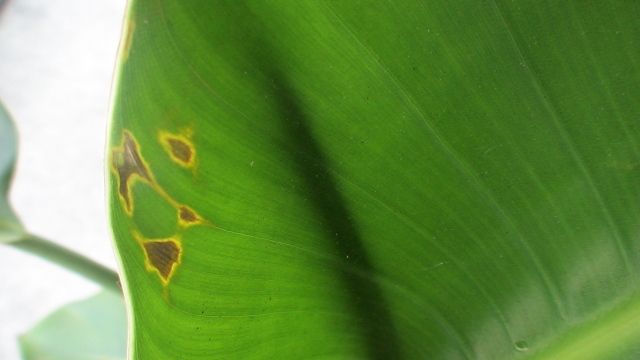Question
 Bird of paradise
Bird of paradise
Dear Darlene,
Thank you for your answer to my previous question on my bird of paradise. It was very helpful. I've recently discovered some brown patches on its leaves. They are not sticky and do not flip off so I'm ruling out of the possibility of scale. The patches appear to be part of the leaves (please view the attached image). I've been misting the plant twice a day in this hot weather. I'd like to know whether the browning indicates a potential problem.
Also, on my newly purchased pothos plant, I've discovered similar brown/yellowish patches as well as holes on some of its leaves. One leaf has so many holes that there is only half of it left. Most other leaves appear healthy without holes. The pothos plant is nowhere near the bird of paradise so I don't think it's a spreading insect issue. I've examined the pothos leaves and was unable to find any bugs. Please let me know what I can do to take care of the problem.
Again I appreciate your help and time.
Juliet
AnswerJuliet,
Bird of paradise leaves can get sunburned or easily bruised by hands touching or bumping. If it spreads more look with a magnifying glass for insects. It could also be from being overwatered. It needs to be dry for 2-3 days between waterings. In other words water on Saturday and if it seems dry by Tuesday let it go and be dry for 3 days and water again on friday. That gives the roots a chance to breath which they need. It is not a swamp plant. Too much water will cause root rot. The brown patches could be from overwatering and spots on the plant ge waterlogged then they dry out and turn brown.
Your pothos vine damage may have been fro a catapillar chewing on the leave and he may have then crawled away and went into his larva stage to hatch out later as a moth or butterfly. That is the kind of damage that happens from catapillars. I would not worry about it unless more leaves are damaged, then you need to look for insects with a magnifying glass and spray the plant well with a 50/50 mix of rubbing alcohol and water to which you have added 1 teaspoon of dish soap per quart of mix. That will kill any insects on contact and the risidual soap will harm aany that come back. Good luck.
Darlene






